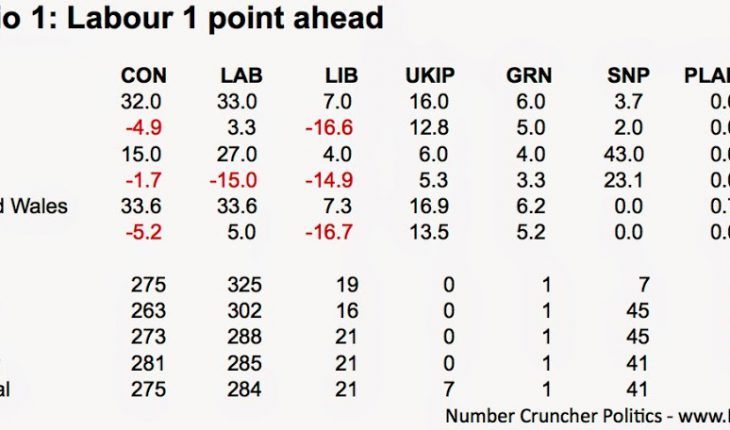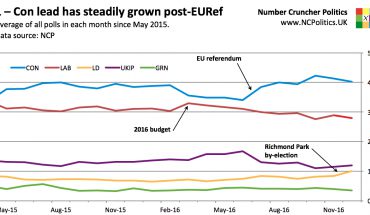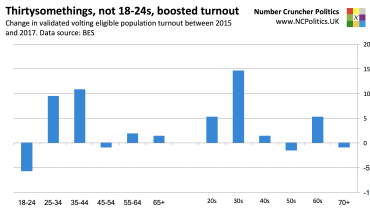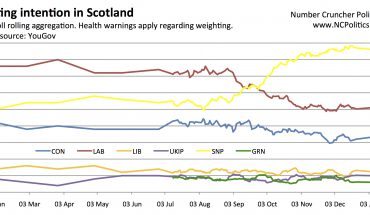So on that basis it looks like Peter Kellner is wrong. But actually, he isn’t – or if he is, it doesn’t make much difference – and here’s why. As I mentioned above, the CON-LAB Swing in England and Wales is bigger than across Great Britain as a whole, at 5.5% using the YouGov numbers. A 2% incumbency adjustment reduces this to 3.5%, half a point less than the swing that YouGov showed nationally, which is exactly the differential that marginals polling has suggested. So it could either be a ‘hidden’ incumbency bonus, or it could be a differential swing, which might be due to tactical voting, regional patterns or just marginals behaving differently. The distinction may be academically interesting, but it affects fewer than five seats (and we don’t have enough data to be sure which it is anyway). But suffice to say, the evidence confirms the sort of pattern than Peter Kellner’s example is based on. This puts both main parties on somewhere close to 280 seats.
But where I would further adjust the raw numbers – which are slightly too favourable to the Tories – are in terms of UKIP seats and contests involving the Lib Dems. UKIP are generally thought to be heading for more than just one seat. Since most of these gains are likely to be from the Conservatives – seats they would then need to win somewhere else – this moves the skew against Tories. And as I wrote last month in a piece for the New Statesman, where the Lib Dems are involved the swings away from them don’t seem to be equal, being a couple of points smaller than nationally in LIB-CON battles, and a couple of points larger in LIB-LAB contests. This would see the Conservatives fall short in a handful of seats they would otherwise expect to win, and give Labour a few extra. I am also using a larger incumbency adjustment of 5% swing (10 points net) for Lib Dems.
The effect of this is also to move the skew back against the Conservatives, but leaving the most likely outcome still half a point in their favour. Effectively, the skew has gone.
So unless there is some other factor that we’ve all totally missed, There doesn’t look like being a popular vote/seats split unless things are extremely close (probably less than a point).
How does this leave the possibility of an overall majority? The aforementioned Labour collapse in Scotland naturally hurts Labour’s chances. It would need to win those seats in England and Wales instead, or put another way, winning a 2-seat majority with 25-or-so fewer Scottish seats would be like winning a 52-seat majority with them. So instead of needing a one point lead as UNS implies, under this scenario Labour would need about a 7.5 point popular vote lead just to win a bare majority, which it hasn’t averaged since 2013. I’ll save a discussion of swingback theory for another time here, but in short it suggests that a move in the opposite direction is likely as the election approaches.
Could the Conservatives win? This is interesting. The analysis suggests that a national vote lead of as little as 2 points would be enough to win 300 seats, making that number far more achievable than commonly assumed. In fact a lead of 4 points would be enough for the Tories to hold on to most of the seats they won in 2010 (those other than where a new MP is stepping down after one term, or seats lost to UKIP) plus some gains from the Lib Dems for a total of around 315 (and probably a minority government).
But getting to 326 is much harder, since there wouldn’t be many more winnable Lib Dem seats, meaning that gains from Labour incumbents would be needed. Because of the differential swings and incumbency, there is something of a ‘no man’s land’ between about 300 and 326 seats (and especially between 315 and 326). So to win an overall majority, the Conservatives would need a much bigger lead of around 7.5 points, about the same as Labour. Naturally either party would need a bigger lead still to secure a working majority.
Essentially what has happened over the last few months is that the wedge – the sector of the swingometer that represents hung parliament territory – has become fatter over the last few months, mostly at Labour’s expense, but it’s not helping the Tories get any closer to the winning line. This explains why there is such a strong consensus around the idea of a hung parliament.
Of course, the popular vote could be dramatically different to current polling. To be clear, this is a estimate of the popular vote consistent with an ‘equal seats’ outcome, not a forecast of what the popular vote will actually be.
(continued…)






